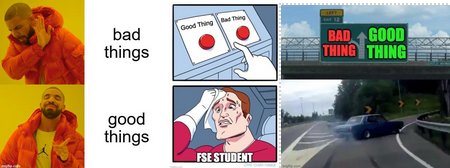This technique was the idea of UMKC faculty member Dr. Dan Scott. For classes where you would like to students to be involved in discussion, the good thing/bad thing exercise can be a way to get them talking at the beginning of a class session with an unrelated topic. The exercise works best if you can repeat on a regular basis to get students comfortable with sharing and instill a habit of looking for the good thing/bad thing each week. If you have a TA, GTA, or other student helper, you can utilize them to help run the exercise to foster engagement between the TA/GTA and students. The first slide after the title could utilize a funny meme to help students remember the goal of the exercise:

First time, the instructor will need to give directions and explain purpose (build rapport and engagement with students). During the exercise, students reflect on their week and tell the rest of the class one “good thing” and one “bad thing” that happened to them. You should emphasize there are no right or wrong answers and students are free to determine what is “good” and what is “bad”. Some students will say the weather is good and some will say the weather is bad. Instructors can use the responses to ask follow-up questions, note if several students are worried about the same exam and suggest a study group, or if follow-up with a particular student is needed (food/housing insecurities, mental health, etc..). Instructors should be included in sharing good thing/bad thing. Also, importantly, stay actively involved in the responses and engage with follow-up questions or make suggestions about resources available. This technique is good for smaller class sizes (30 or less) and takes about 10 minutes. Some benefits of the technique include students recognizing others are going through the same struggles, identifying other students with whom they could study, and getting to know each other and used to speaking up in class. A modification would be for students to say their names as a way to help the instructor learn names. Lastly, if your class meets more than once/week, only use the exercise for one of the days. I would imagine asking multiple times/week would lessen the effectiveness of the exercise.
I used the Good Thing/Bad Thing technique during the Fall 2023 semester in First Semester Experience course. Overall, I think the students enjoyed starting the class with sharing. There were times when the comments were more superficial and I tried to ask questions to get at more specifics. I would also try to remember past comments and ask follow- ups.